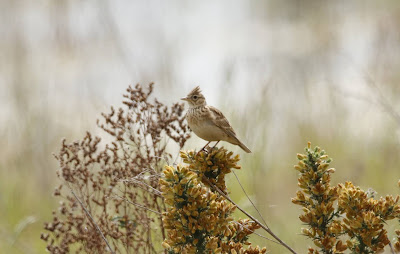Despite the lockdown easing I have decided to remain loyal to my local sites, giving the attention I never afforded them before. These places have become very important me, not just as places to bird watch, but places to really connect with nature. Today I travelled to Pipps Ford, which I have mentioned before is the best birding place in the area. With recent high temperatures I hoped to get an early morning trip in, but being so bad at getting up in the morning I wasn't really able to.
Arriving mid-morning the sun had yet to reach it sweltering height. On the exhausted quarry ground water was still high, covering part of the land. SKYLARKS chirruped in the grassy areas with some occasionally started into brief song before realising they had no need to sing anymore.
Walking the path that cuts the site in two, a path that leads down to the river, the deep water of the active quarry shimmered in the sun, too distant to yet see.
As it still harboured water the exhausted quarry had a decent amount of waterbirds. The nesting COOTS had finally hatched their brood, joining the older ones present since mid-May. Also newly arrived were four tiny LITTLE GREBE chicks, the adult pair getting quite territorial when a third bird turned up, and a fight broke out.
A BANDED DEMOISELLE, distinguished by its black tipped wings
The river was quiet. The Gipping becomes overgrown with reeds in its quieter sections and attracts singing REED WARBLERS. Clouds of BANDED DEMOISELLE were along the river, dainty little damselflies with distinctive black wing tips, they would alight for a short time, giving time to take a photo before fluttering off.
I followed the path north to Riverside Farm Pit, a small lake bordered by bulrushes and rough grass. Its fairly quiet here, being fairly small, but including young birds there were a whopping 20 CANADA GEESE present.
A family party of CANADA GEESE, Riverside Farm Pit
From this lake I walked back south along the river. As a bridge crossed a tributary a MARSH TIT was a good find, looking for insect prey it must be nesting nearby.
To get to Pippins Lake and the Active Quarry the path branches off to follow this tributary.
Pippins Lake is surrounded by tall trees and there is no view until you reach the top of the lake. On 16/6 a HOBBY was a brief delight, flying over the water before disappearing from view. Three broods of GADWALL were present with another 16 adult birds, which is a great number for mid-Summer. However when I came back on 25/6 all the birds had gone, and the lake was overgrown with this thick algae. However, still around were the family of SWANS which have been present since lockdown eased.
Bulldozer on the Active Quarry
From Pippins Lake, the path wanders over to the back of the active quarry, which allowed a closer look at the deep sided lake. This is a sand quarry, the excavation of which has shaped the land in the area, and it changes from year to year.
Around ten TUFTED DUCK are over summering here, whilst a pair of GREAT CRESTED GREBE were nesting on one of the islands. SAND MARTINS as usual drifted through the air.
A pair of LITTLE RINGED PLOVERS were present on a nice area of wet mud, and are probably breeding there. If this habitat stays this way it might attract some migrant WADERS down to feed as we get later into the year and Autumn migration starts.
The active Quarry
From the active quarry the path reconnects with the river. Walking back along here I disturbed a CUCKOO, which flew from perch to perch in front of me as I unintentionally disturbed it. Cuckoos have the appearance of a sharp winged bird of prey in flight but a closer look can always distinguish them. It was good to see such an iconic yet now scarce bird, I just use have to think back to my childhood when I used to hear them from all around the general countryside.
The cuckoo was the last interesting bird I saw and rounded my trip off nicely.
The river Gipping is full of life
The height of summer isn't really the best time to go birding, as birds are being secretive raising families, and adding in the factor of high temperatures it really isn't the best time to go looking. So I count it as bonus that I was able to see the birds I did. I like this area, its easy to birdwatch, and you don't really see a soul, being so far from the nearest built up area. Autumn migration should be starting soon which should bring in the first of the WADERS, this site being one of the best for inland Suffolk, and hopefully something interesting should turn up.


















